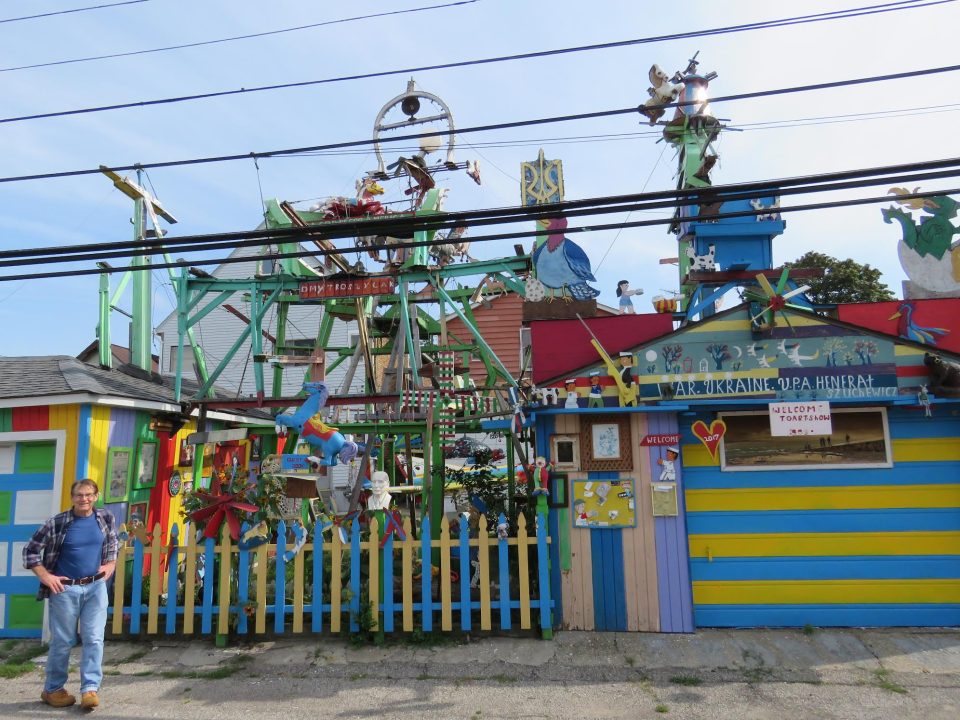By Jim Bloch
A new survey by Rivers Wall Art, an art distribution company based in Cedarville, Texas, surveyed over 3,000 art lovers across the U.S. “to find out which lesser-known installations, sculpture parks, and downright bizarre public art displays they would most like to visit this year.”
Hamtramck Disneyland, a yard full of unusual, colorful and found items – think upside down cat sculptures, clowns and rollercoaster-like constructions — came in 21st. Two other Michigan sites also made the list: Lansing’s ArtPath was selected at 70. Ludington’s cARTier Trail came in at 115.

The top 10 consisted of Kakaʻako Street Art in Honolulu, Oahu, Hawai’i; the Coral Castle in Homestead, Florida; Olympic Sculpture Park in Seattle, Washington; Pu’unhonua o Honaunau Wooden Carvings on the Big Island, Hawai’i; the Beale Street Brass Notes Walk of Fame in Memphis, Tennessee; Music Box Village in New Orleans; Wild Blueberry Land in Columbia Falls, Maine; Cloud Chamber for the Trees and Sky in Raleigh, NC; The Whale Bone Arch in Barrow (Utqiagvik), Alaska; and the Sun Tunnels in the Great Basin Desert, Utah.
“The results were surprising and very revealing about what people value in their cultural detours,” said Rivers Wall Art on its website. “Our survey makes one thing clear: when it comes to public art, Americans are less interested in pristine sculpture gardens and more drawn to places where art feels alive, improvised, or deeply connected to the land it inhabits. From bottle chapels and whirligigs to cornfields and camera obscuras, we’re witnessing a quiet shift away from gallery walls and toward art that invites wonder, confusion, or even a little participation.”
Hamtramck Disneyland
The nearly 2,000 square foot installation was created by Dmytro Szylak, a Ukrainian immigrant to the Motor City. Szylak and his wife settled in Hamtramck, a city within the borders of Detroit, in the 1950s. Szylak worked for GM for 30 years. He then spent the next 30 years building, editing and enhancing his wacky folk-art project at 12087 Klinger.
The site may be viewed from the alley between Sobieski and Klinger streets, north of Commor and south of Carpenter. From the alley, two boldly striped garages frame what appears to be a nutty, rickety version of a wooden rollercoaster painted pale green and rising above more than a half dozen power lines.
The yard bursts with a carnival of differently colored rocking horses, propellers that turn in the wind, clowns, neon sign frames, giant birds, cutouts of sailors, a fire-breathing dragon breaking free of its shell, dogs, rabbits, newspaper articles in hand painted frames, nostalgic artwork, and a guest book, all of it enclosed by a fence, the pickets of which alternate between blue and yellow.
After Szylak died in 2015 at 92, the Hatch, an art collective and gallery in the old police station, began managing the site.
Hamtramck Disneyland is one of three famous folk-art installations in Detroit along with Heidelberg Project and MBAD African Bead Museum.
Lansing’s ArtPath
The 2.5-mile river path led visitors past 20 sculptures and murals in downtown Lansing. The project, which began in 2018 with 10 artworks, was a partnership between the city’s parks and rec department and the Lansing Art Gallery and Education Center, which closed its doors in April after 60 years of serving the community. It wasn’t clear if the parks and rec department was continuing ArtPath without the gallery. The department did not return a phone message. Normally, the trail was open Memorial Day through Labor Day.
Ludington’s cARTier Trail
The one-mile Cartier Trail in Ludington’s Cartier Park features three artworks in metal frames four-feet by three-feet. Three new pieces are selected each year by the Ludington Area Center for the Arts. The trail is “uniquely accessible and enables people to experience art in the course of daily life, outside of museums or other cultural institutions,” LACA director Andrew Skinner told MLive in June.
It’s open year-round.
Jim Bloch is a freelance writer based in St. Clair, Michigan. Contact him at bloch.jim@gmail.com.



